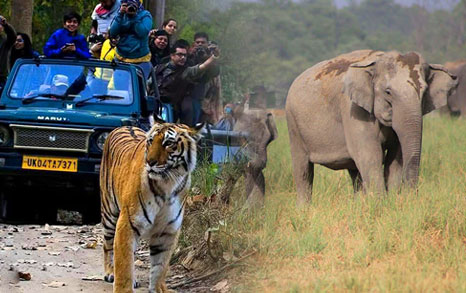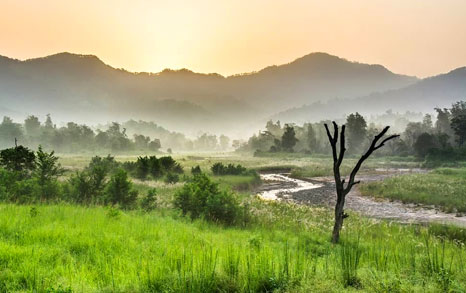Best Time to Visit Rajaji
Rajaji National Park is nestled on the foothills of the Shivalik range and spread across three districts of Uttarakhand, and is a blessed location with pleasant weather conditions almost throughout the year. When planning a visit to Rajaji National Park, timing is crucial to ensure an unforgettable wildlife experience. Understanding the best time to visit Rajaji National Park will help maximize the chances of spotting wildlife, enjoying the lush greenery, and experiencing the park in its full splendor.
The park remains closed from June 15th to November 15th due to the monsoon season, making it advisable to avoid planning a safari during this period. As the park reopens in October, Rajaji National Park greets visitors with lush greenery and a rejuvenated environment. Jeep safaris resume, allowing visitors to explore the heart of the forest, now enveloped in the vibrant green landscape of Rajaji's wilderness.


Peak Seasons:
Rajaji in Winter: November to February (10°C to 20°C)
The winter months are the peak season for exploring Rajaji National Park. This post-monsoon period is particularly favorable for wildlife sightings, especially elephants and deer gathering at waterholes. The sparse foliage during this time enhances visibility, making it an ideal season for park exploration. December and January are the coldest months, so warm clothing is recommended. As February approaches, the cold begins to wane, marking the transition from winter to spring and eventually into summer. The increased visibility of birds further enhances the appeal of a winter visit, making this season the prime time to experience the natural wonders of Rajaji National Park.
Rajaji in Spring: March to April (15°C to 25°C)
As winter recedes, spring brings with it delightful weather, making it an ideal time for morning safaris. This enchanting season showcases a vivid display of blooming flora throughout the park, accompanied by the graceful arrival of migratory birds, including the magnificent paradise flycatcher. Bird enthusiasts are rewarded with sightings of a diverse array of avian species, further enhancing the park's natural beauty and charm.
Rajaji in Summer: May to June (22°C and 38°C)
The summer season can be quite warm for embarking on a safari in Rajaji National Park, particularly during the afternoon. Afternoon safaris may prove challenging due to direct exposure to sunlight. A morning Jeep safari is therefore the optimal choice for experiencing the national park's scenic beauty and diverse flora and fauna. Wildlife sightings are at their highest during the summer, making it a favoured time for tourists to visit Rajaji. To ensure a comfortable and enjoyable safari experience, it is advisable to dress in light, breathable fabrics, particularly cotton, wear hats, apply adequate sunscreen, and stay well-hydrated.
Off Season:
Monsoon Season: Mid-June to Mid-November
Rajaji National Park receives a considerable amount of rainfall during the monsoon season, mainly from July to September being a forest region, the safari routes become mud-loaded and water accumulates in some areas of the national park. In order to avoid any kind of unwanted situations Rajaji National Park discontinue safari activities from mid-June to mid-November. Entry of tourists is also restricted during these rainy months. Therefore, while planning a trip to Rajaji National Park consider the month for the trip to enjoy a smooth and thrilling experience.